Click on images to enlarge

habit (Photo: Sheldon Navie)

habit prior to flowering (Photo: Sheldon Navie)
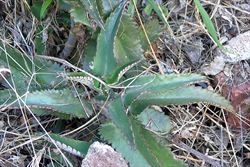
leaves (Photo: Sheldon Navie)

close-up of leaves showing variegated undersides (Photo: Sheldon Navie)
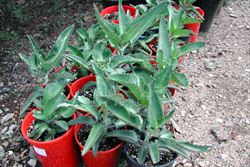
young cultivated plants (Photo: Sheldon Navie)
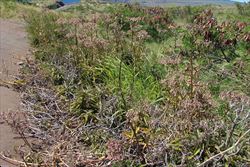
infestation along a roadside (Photo: Forest and Kim Starr, USGS)

dense infestation with old flowering stems (Photo: Forest and Kim Starr, USGS)

habit in flower (Photo: Forest and Kim Starr, USGS)
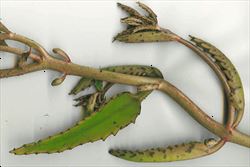
close-up of stem and narrower upper leaves (Photo: Forest and Kim Starr, USGS)

branched flower clusters (Photo: Forest and Kim Starr, USGS)
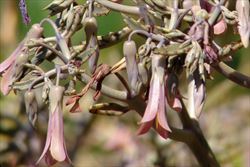
drooping flowers (Photo: Forest and Kim Starr, USGS)
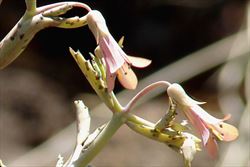
close-up of flowers (Photo: Forest and Kim Starr, USGS)

donkey ears (Bryophyllum gastonis-bonnieri), a similar cultivated species (Photo: Sheldon Navie)
Scientific Name
Bryophyllum daigremontianum (Raym.-Hamet & H. Perrier) A. Berger
Synonyms
Kalanchoe daigremontiana Raym.-Hamet & H. Perrier
Family
Crassulaceae
Common Names
chandelier plant, devil's backbone, Mexican hat plant, mother of millions, mother of thousands, mother-of-millions, mother-of-thousands
Origin
Native to Madagascar.
Naturalised Distribution
This species has occasionally become naturalised in south-eastern and northern Queensland, and has also been reported from inland northern New South Wales (e.g. near Lightning Ridge).
Naturalised overseas in Hawaii, the US Virgin Islands, Puerto Rico, south-eastern USA (i.e. Florida) and New Caledonia.
Notes
Mother-of-thousands (Bryophyllum daigremontianum) is a minor environmental weed in Queensland and New South Wales. It is easily confused with hybrid mother-of-millions (Bryophyllum x houghtonii) and so its distribution and impact may be underestimated. It is weedy on the opal fields near Lightning Ridge in northern New South Wales and is also present in many parts of Queensland. Its impacts are likely to be similar to other species of mother-of-millions (Bryophyllum spp.), but it is far less common.

